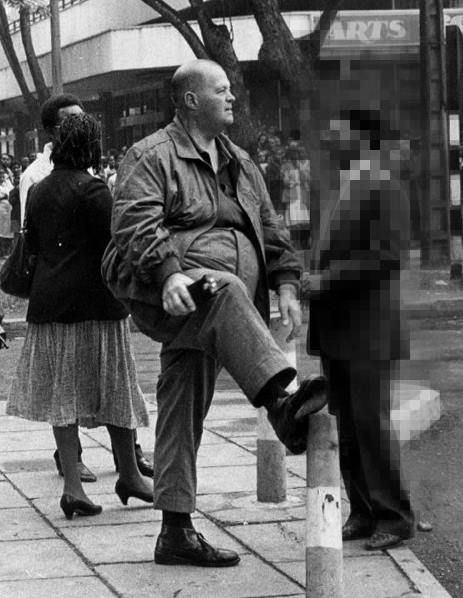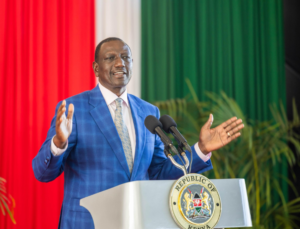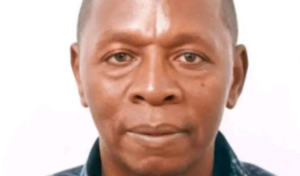Patrick Shaw: The Cop Who Was Dreaded By Thugs In Nairobi

Pimps, thieves and prostitutes came to see big Pat Shaw buried. So did Nairobi’s top police brass and the chief justice of Kenya’s supreme court.
The lawmen came to say goodbye to Africa’s most famous white cop, a big man with a bigger reputation for always getting his man, one way or another. The pimps and prostitutes, who had been Shaw’s informers, came to gaze on the body of a giant who had terrified them for so long.
The thieves, it is said, crept up to convince themselves that Pat Shaw really was dead.
Patrick David Shaw, all 6 feet and 300 pounds of him, was a legend in a land that loves myths and mystery. He died of a heart attack at age 52, leaving a legacy of shootouts, car chases and lingering questions about men who turned up dead when they crossed Pat Shaw.
When a bank was robbed or a merchant shot, Shaw was always the first on the scene, roaring up in his specially equipped cream Mercedes, his .38 special tucked under his arm.
He was a cop who rarely slept. Because of a glandular disorder, his friends now say, Shaw was so obese that he could not lie down. His Mercedes was equipped with a police radio and a special seat that tilted back to let him sleep on the few occasions when sleep would come. His friends say he never slept more than two hours a night.
So day and night, year after year, Pat Shaw drove the roads of Nairobi, waiting for a crime to be committed. He killed or captured dozens of thieves and murderers.
Other than helping to run a boys’ orphanage, Shaw had no interests in life beyond chasing criminals. He was not married and never took a vacation. He read FBI manuals and “wanted” posters in his car. He had practically memorized the Kenya Penal Code.
But on the streets, everyone knew Pat Shaw. He could clear a sidewalk just by stepping out of his car.
Shaw was not even a regular police officer. He was merely a member of the Kenya Police reserve. Yet the entire police hierarchy was in awe of him because he could do one thing better than any other cop in Kenya: eliminate criminals.
Though Shaw worked for African police officials and had African friends, many Africans were terrified of him. They had heard tales of all the men he had killed – virtually all of them black. Many were convinced he would shoot them if they got in his way; some said he had mystical powers.
They knew his license number by heart: KFH845. They ran for cover when they saw it. A Nairobi legend has it that mothers scolded their children with the warning: “Be good, or Pat Shaw’s gonna get you.”
According to Shaw’s police associates, dozens of wanted criminals who heard Shaw was looking for them simply turned themselves in.
 “An aura of fear had built up around him, and he used it to his advantage,” said a former Nairobi police officer who worked with Shaw for more than 20 years. “A lot more men gave up out of fear than were ever shot by Pat.”
“An aura of fear had built up around him, and he used it to his advantage,” said a former Nairobi police officer who worked with Shaw for more than 20 years. “A lot more men gave up out of fear than were ever shot by Pat.”
For all the terror Shaw and his massive bulk inspired, he was widely respected. When a member of parliament complained about a mzungu – a European – seemingly running the police force, the justice minister told the politician to shut up and never criticize Pat Shaw again.
People on the streets, black and white, would often cheer as Shaw drove by. His network of informers and tipsters, most of them black, was legendary.
So was his kill ratio. For years, it was said that criminals caught by Shaw were never seen again. It was rumored, too, that he took care of political dissidents – notably J. M. Kariuki, an opposition politician who was killed in 1975 after allegedly being led by Shaw from a Nairobi hotel the day he died.
“Shaw had a certain value as a white man who was willing to follow any order,” said a Westerner familiar with political intrigue in Kenya.
Shaw’s friends bristle at suggestions that he was a vigilante or hired gun. They point out that he appeared regularly in court as a witness against men he had captured. They say he was simply a magnificent cop with a special talent and drive for tracking down criminals.
“If Pat confronted an armed man, he would shoot first – always,” said a longtime police colleague. “And if a man tried to escape, he’d kill him. But that’s it. He never, ever shot a captured man.”
Nairobi’s political magazine, the Weekly Review, suggested that Shaw’s ruthless image was calculated: “Mystery always seemed to surround the man. The police were probably content to leave matters so, in order to enhance the aura of invincibility that surrounded him.”
Shaw was certified as a living legend in June 1977, nearly 18 years after he joined the Police Reserve. That month, a thug named Danson Gachui went on a rampage. He was wanted for 10 robberies, a murder, and for stealing machine guns from two Nairobi cops at gunpoint.
Read: NTSA Announces Introduction Of E-logbooks
Gachui, whom the Standard called “Nairobi’s most wanted criminal,” had survived two shootouts with police. He was feeling cocky; he challenged the famous Pat Shaw to a shootout.
Shortly after the challenge, police spotted Gachui driving a stolen Audi. After a long car chase, they overtook him in the ramshackle neighborhood known as Nairobi South “C.”
There, Gachui leaped from his car and opened fire with two pistols at a police officer whose car had roared up behind him. As the Standard reported it: “The officer shot the gangster dead through the mouth.”
The Standard didn’t say so, but everyone in town knew the officer was Pat Shaw.
Several years later, a criminal known only as Wakinyonga – the Killer – was celebrating his latest robbery, drinking beer in a bar with his girlfriend in the Kangemi area of Nairobi. Someone tipped off Pat Shaw, who rounded up his men and surrounded the bar.
Wakinyonga was ordered to surrender. He refused, and opened fire. One of the cops fired back and killed him. Everyone says the cop was Pat Shaw.
Another police officer suffered a mental breakdown just outside Nairobi and began waving his gun and screaming wildly. The first cop on the scene was Shaw. The officer fired at Shaw and tried to ram Shaw’s Mercedes with his police vehicle.
Shaw didn’t shoot. He ordered the officer to drop his gun. The cop obeyed.
Only once did someone get the better of Pat Shaw in a shootout – and that was only because Shaw wasn’t carrying a gun.
In 1979, a Ugandan outlaw named Walimba murdered a Nairobi family. Shaw was at the murder scene so quickly that Walimba was still there. He shot Shaw in the shoulder and fled. Shaw drove himself to the hospital, was treated, and then drove home.
From then on, Shaw was never without his .38 special. He switched last fall to a 9mm Beretta automatic, wanting a faster-firing weapon.
Among the many things that amazed Shaw’s friends were his fast feet. For all his bulk, he was a remarkably fast runner for short distances.
Once, he literally ran down a murder suspect in the woods near the Nairobi casino. One friend recalled watching Shaw sprint after a pickpocket and catch him in downtown Nairobi.
“I’ve seen him run when he really meant it, and gosh jove, he was like greased lightning,” the friend said.
In a rare press mention of Shaw, the Nation newspaper ran a story in November 1986 about Shaw running down two bank robbers downtown.
One suspect “was driven away by police reservist Patrick Shaw to an unknown destination,” the Nation reported, “only to be brought back at around 3:30 p.m., thoroughly subdued, shirtless but with a coat, and with traces of blood behind his ears.”
A Nation photo showed Shaw, wearing a tie and looking smug, with one hand on his hip and the other clutching the suspect’s arm.
“He was absolutely fearless,” said the security official who knew Shaw well. “It’s a miracle he was never killed. Maybe people were afraid bullets would bounce off him.”
Joseph Karimi, news editor of the Nation, remembers Shaw taking over his news desk to create an instant command post after a bank robbery.
“Now that he’s dead, all the thieves are back in town,” Karimi said.
Shaw died at the Nairobi home of a former police commissioner. He had dropped by during his rounds, his Mercedes backed in and ready to roll. He held a portable police radio, listening for his code name – ROMEO 9. His friends said he keeled over and was dead in minutes. His Beretta was in his shoulder holster.
“CRIME BUSTER PAT SHAW IS DEAD,” read a huge headline on the government- run Kenya Times the next day.
His friends remembered him as articulate and extremely well-read, with a surprisingly soft voice. He was the son of a prominent London doctor; he moved to Kenya as an agricultural officer in 1955 and became a Kenyan citizen in 1971.
On Feb. 20, Shaw was buried in an oversize teak coffin. President Daniel arap Moi, who had awarded Shaw the Silver Star in December, sent a message calling him “constant, selfless, sacrificial.”
Even so, people always wondered about Pat Shaw, dead or alive. A British reporter visiting Kenya began interviewing people about Shaw for an article on the big, tough cop he had heard so much about.
One night, the reporter answered a knock at his hotel room door. There stood Pat Shaw.
“I heard you’ve been asking around town about me,” Shaw said.
The reporter nodded.
“Don’t,” big Pat Shaw said, and walked away.
Source: Facebook




